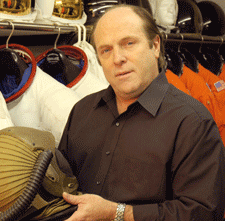Space Suits: The Next Generation
Hundreds of people have already signed up for suborbital flights into space through Virgin Galactic, one of several firms that plan to offer such trips by 2010. But what are all those space tourists going to wear?

A new company called Orbital Outfitters is already at work on a space suit specifically designed for suborbital tourism. Last week, Orbital announced that it had signed a contract with XCor Aerospace, of Mojave, CA; the companies will work together on finalizing a space-suit design and other safety equipment. Orbital Outfitters will manufacture and own the suits, which will be leased to XCor.
“Billions of dollars are flowing into all kinds of new commercial spaceships, which will carry all kinds of people into space,” says Rick Tumlinson, president of Orbital Outfitters. His company intends “to help make this happen, make it happen in style, and make it happen at a profit.” Orbital hopes to unveil its first designs in the next few weeks.
The requirements for space suits for the new tourist vehicles are quite different from those for conventional, government-run spacecraft like the shuttle, says XCor president Jeff Greason. The suits need to be more flexible and comfortable and much cheaper, while still able to provide lifesaving protection from the near vacuum of space in the event of an accident.
“We’ve been working on getting a suit for personal spaceflight for a long time,” Greason says. Neither he nor Orbital officials would discuss any of the key proprietary aspects of the suit, but Orbital has come up with an “innovative strategy” to meet the wearer’s needs, Greason says. The key requirement is that the suits be affordable, available in a range of sizes, and flexible and comfortable in their unpressurized state. In the event of a loss of pressure at the top of a craft’s flight into space–XCor’s planned Xerus craft would ascend to about 350,000 feet–the suit would need to inflate quickly to provide full life support.
Existing space suits like those designed for the shuttle, Greason says, “are really for a cadre of very well-trained, highly motivated astronauts.” For the new rockets, “we need life support to handle the less trained participant.” And with his own six-foot-two, long-waisted, and slightly pudgy frame, he says, “I myself don’t fit any existing space suit.”
While depressurization in space is considered extremely unlikely, Greason says, it’s important to be prepared, just in case. “We couldn’t convince ourselves [a problem] was not possible,” he says. “A large fraction of fatalities in government-sponsored programs were preventable.” In the Soyuz 11 flight in 1971, in which three cosmonauts died, and in the Challenger shuttle accident that killed seven astronauts in 1986, the crews might have survived if they had been provided with the pressure suits that are now given to all crews.
But the company intends more than just emergency protection. Since the new flights are aimed at the general public, Orbital hopes to design suits with a “wow” factor that could woo a secondary market for space apparel: people who won’t even use them in space. Toward that end, the company hired Chris Gilman, a designer whose primary experience has been designing very realistic space suits for Hollywood movies and television programs.
The team’s first design, a suit called IS3 (for Industrial Suborbital Space Suit), was created to give “life-support functions for 30 minutes or longer at 500,000 feet, superior visibility of the user, and maximum mobility,” Gilman says. “They are comfortable to wear, while looking very cool.”
Tumlinson says the suits are made up of separate components and that “we are going to offer our customers the chance to buy the outer layers of their suits as souvenirs.” His company will later produce spin-off apparel based on the new designs. While the inner pressure shell of the suits will be a standard design, the outer shell will have custom colors and designs for each of the space-tourism companies, he says.
The business may be just the beginning of a wave of companies hoping to take advantage of the emerging new industry. The idea is to provide a variety of products and services to support the hundreds of annual tourist flights from as many as a half-dozen new commercial spaceports–in Texas, California, New Mexico, Oklahoma, Florida, and Nova Scotia–that are expected to begin in the next few years. Besides Virgin Galactic–founded by Virgin Atlantic chairman Richard Branson and X Prize winner Burt Rutan, designer of SpaceShipOne–the new companies include Blue Origin, founded by Amazon.com CEO Jeff Bezos; Armadillo Aerospace, founded by video-game designer John Carmack; and SpaceX, headed by PayPal founder Elon Musk. A market study by Bethesda, MD, consulting firm Futron projected that within 15 years there could be 15,000 annual suborbital tourist flights and 60 orbital flights, generating $1 billion in revenue.
“This is a new era, starting right now, in space,” says Tumlinson, whose company’s motto, derived from the title of a Robert A. Heinlein science-fiction novel, is “Have space suit, will travel.” Orbital’s first space suits will be delivered to XCor next year.
Keep Reading
Most Popular
Large language models can do jaw-dropping things. But nobody knows exactly why.
And that's a problem. Figuring it out is one of the biggest scientific puzzles of our time and a crucial step towards controlling more powerful future models.
The problem with plug-in hybrids? Their drivers.
Plug-in hybrids are often sold as a transition to EVs, but new data from Europe shows we’re still underestimating the emissions they produce.
Google DeepMind’s new generative model makes Super Mario–like games from scratch
Genie learns how to control games by watching hours and hours of video. It could help train next-gen robots too.
How scientists traced a mysterious covid case back to six toilets
When wastewater surveillance turns into a hunt for a single infected individual, the ethics get tricky.
Stay connected
Get the latest updates from
MIT Technology Review
Discover special offers, top stories, upcoming events, and more.